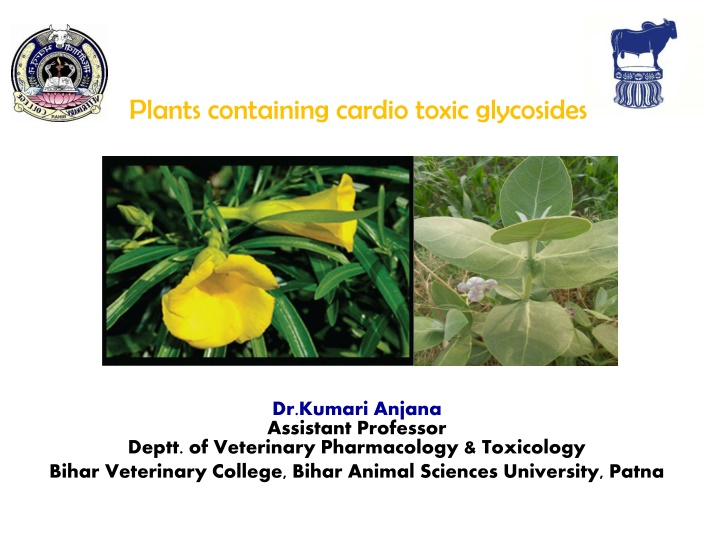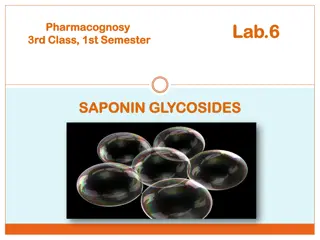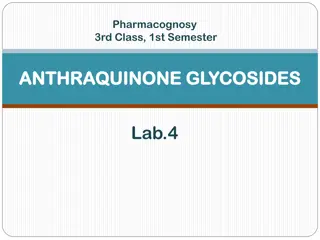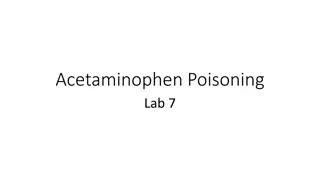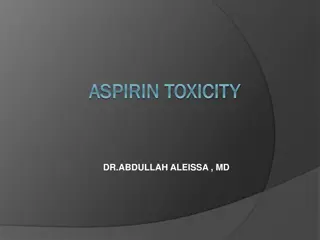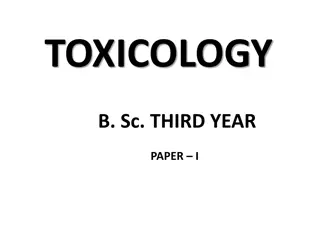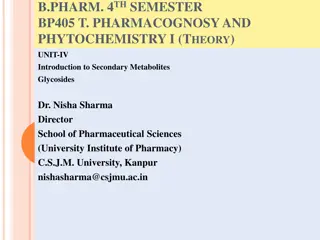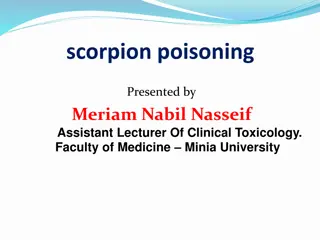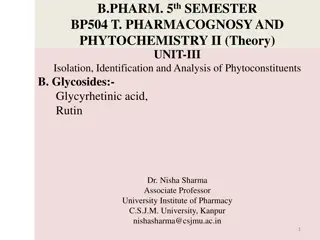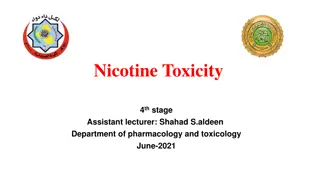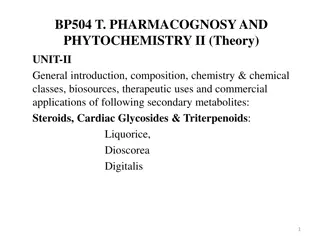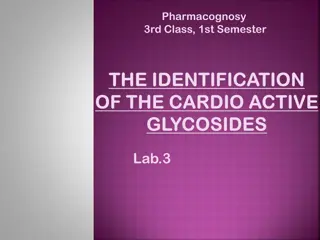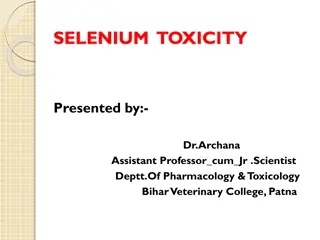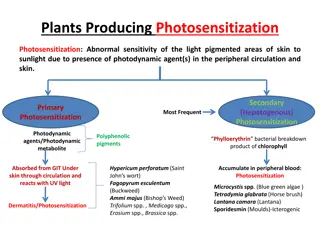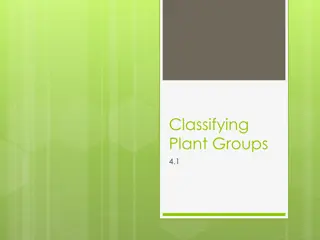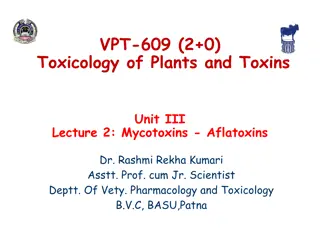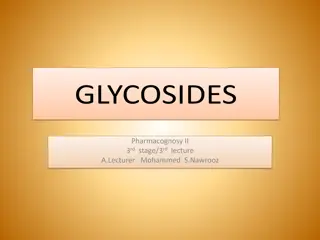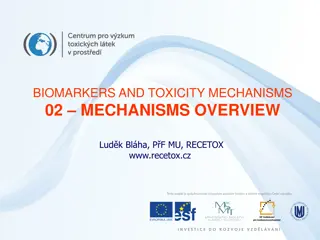Cardiotoxic Glycosides in Plants: Toxicity and Mechanism of Action - Overview
Plants like Nerium oleander, Thevetia peruviana contain cardiotoxic glycosides causing toxicity in animals and humans. Poisoning with these plants can be fatal, affecting the heart and nerves. Toxicity is mainly due to compounds like oleandroside and oleandrin, leading to cardiac failure and gastrointestinal issues. Understanding the mechanism of action is crucial in managing poisoning cases. Adequate awareness is necessary to prevent accidental ingestions.
Download Presentation

Please find below an Image/Link to download the presentation.
The content on the website is provided AS IS for your information and personal use only. It may not be sold, licensed, or shared on other websites without obtaining consent from the author.If you encounter any issues during the download, it is possible that the publisher has removed the file from their server.
You are allowed to download the files provided on this website for personal or commercial use, subject to the condition that they are used lawfully. All files are the property of their respective owners.
The content on the website is provided AS IS for your information and personal use only. It may not be sold, licensed, or shared on other websites without obtaining consent from the author.
E N D
Presentation Transcript
Plants containing cardio toxic glycosides Dr.Kumari Anjana Assistant Professor Deptt. of Veterinary Pharmacology & Toxicology Bihar Veterinary College, Bihar Animal Sciences University, Patna
Nerium oleander, N. indica (Kaner) Nerium oleander, (Kaner): these are medium shrubs with sweet scented white, pink or other colours of flowers, mainly grown as an ornamental plant in temperate climates. Poisoning occurs by ingesting (scarcity periods) the leaves or pods (seeds). Another species of oleander are N. Indicum (kaner) and Thevetia peruviana (Yellow oleander, pilla kaner). All parts of the plant are toxic. The plant is highly poisonous. The milky juice - contains high concentration of toxic principles.
The seeds of yellow oleander Thevetia peruviana or Cerebera thevetia are highly poisonous to both man and animals (used for malicious killing of animals and for homicide purpose). They contain cardiotoxic glycosides thevetin and cereberin causes toxicity similar to N. oleander.
Toxic principle Toxicity is mainly due to presence of cardiotoxic digitalis- like glycosides: oleandroside, nerioside, oleandrin, neriodrin, folinerin digitoxigenin. The plants also have alkaloids : pseudocurarine, neriene and neriantine. The cardiotoxic glycosides are found in all parts of the plant parts, but growing tops and leaves are most toxic.
Toxicity Oleander is toxic to all animals and birds. Poisoning is mostly seen in horses, cattle and sheep. Many cases of poisoning have been noted in human beings, particularly in children. Toxic doses are approximately 0.005% of body weight in horses and cattle, and 0.015% in sheep. Mature cattle and horses may be killed after eating 30-50g of oleander leaves. One leaf can kill an adult human and 2-3 leaves can kill an adult sheep.
Mechanism of action Theoleander glycosides have action on heart similar to digitalis. Poisoning is of acute type and death results from failure of contraction of myocardium. They interfering with Na+/K+- ATPase enzyme system (sodium- potassium pump) resulting in increased intracellular sodium and serum potassium concentrations and paralysis of sympathetic nerve supply to heart. This results in progressive decrease in electrical conductivity through the heart causing conduction block and eventual asystole. The leaves/pods/seeds also cause intense gastroenteritis.
In low doses, they may have beneficial therapeutic effects like digitalis by increasing the force of contraction, slowing heart rate and enhancing cardiac output. In toxic doses, most cardiac glycosides cause a variety of arrhythmias disturbances that results in decreased cardiac output and death. There is also due to initial stimulation followed by paralysis of vagus nerve . and conduction
Signs The toxicity signs are vomiting, abdominal pain, tenesmus, cardiac (bradycardia, systoles, tachycardia, and heart block), laboured muscular tremors, convulsions, paralysis and death. diarrhoea, arrhythmia premature breathing, Milk from poisoned cows may also cause toxicity in man (salivation, vomiting, diarrhoea, weakness, visual difficulty and even convulsions). muscular
Treatment Treatment is symptomatic. Remove the source and reduce the absorption (emetics: apomorphine, purgatives, gastric lavage and demulcents). osmotic or saline Administer sedatives/tranquilizers etc. atropine along with propranolol, Infusion contraindicated (aggravates cardiac arrhythmia). of calcium containing fluids is
Calotropis procera/gigantea Calotropis procera/gigantea: Used for malicious killing of animals. A shrub usually found on the boundaries of crop fields and in waste lands. All parts of plant are toxic. The plant is not palatable, hence not usually eaten by the animals.
The toxic principles are : cardiotoxic glycosides calotroxin, calactin, gigantin, Uscharin The latex is an irritant to skin and mucous membranes, if placed in eye causes conjunctivitis and extreme cases blindness.
Following oral ingestion its leaves or fruit cause severe gastroenteritis and cardiac arrhythmia anddeath is due cardiac arrest.
